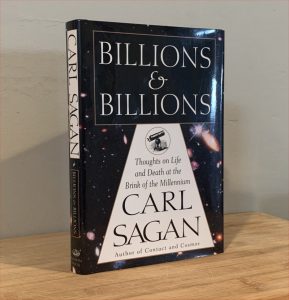 Carl Sagan: BILLIONS & BILLIONS: Thoughts on Life and Death at the Brink of the Millennium (1996, Random House)
Carl Sagan: BILLIONS & BILLIONS: Thoughts on Life and Death at the Brink of the Millennium (1996, Random House)
This was Carl Sagan’s final book, it says, published in 1997 not long after his premature death in 1996 at age 62. Actually, there was one further book, The Varieties of Scientific Experience, published in 2006, based on a series of 1985 lectures, belatedly assembled by his widow Ann Druyan. (Post about it here.)
This book is a collection of essays on various topics, many, the author acknowledges, based on shorter essays written for Parade magazine. This is an interesting point for a couple reasons. Parade is a Sunday supplement magazine that’s been distributed to newspapers in the US for decades, and so its topics have always been light. Also because these days, as I see it inside the San Francisco Chronicle, it’s very thin, mostly full of ads and clickbait-like lists of recipes or celebrity factoids (and a quarter page single Q&A by Marilyn Vos Savant), with no essays even approaching a 10th the length of Sagan’s essays in this book. Parade in the 1980s and ‘90s, when most of these essays were first published, must have been quite different.
The book is divided into three sections:
- The Power and Beauty of Quantification
- What Are Conservatives Conserving?
- Where Hearts and Minds Collide
Highlights:
- In the lead essay Sagan challenges the cliché that he was famous for the phrase “billions and billions,” though in fact he never said it. Johnny Carson (in the 1980s and ‘90s host of late-night TV show The Tonight Show) said it, in mocking affection. Sagan goes on to explain large numbers, and exponential notation.
- Other essays in this first section go on to discuss the Persian Chessboard—the power of exponents, and how it applies to various then-current crises. How sports is a channeling of hunting instincts. Akhnaton, dripping faucets, frequency and wavelength. Four great cosmic questions: life on Mars?, life on Titan?, intelligent life elsewhere?, origin and fate of the universe?, and thinks progress will be made on these questions in the next decade or two. And then: speculation on how many planets there must be in the Milky Way, and how we’ve begun to detect them. [[ This field has exploded in the past two decades. ]]
- The second section dwells on environmental risks. We’re in an enclosed ecosystem; via our technology we’ve become a danger to ourselves. [[ This was in the ‘90s. Since Sagan’s Cosmos in 1980, he’d been warning about that, as was the scientific community, about climate change. ]] The ozone layer; global warming; right-wing denial and resistance (thus the title of this section – the answer as always is short-term priorities and business interests); coal and fossil fuels; how warming is man-made. Practical suggestions for mitigation, the need for a new world-wide energy economy; alternative fuels; how to reduce CO2 already in the atmosphere (cf. the new Elizabeth Kolbert book); how this forces us into a new way of thinking (cf. the new Adam Grant book).
- And how science and religion have tried to converge on the need to preserve the planet, with 1988 and 1990 conferences.
- The third section concerns conflicts. The first essay is about the relationship between the US and the Soviet Union, to be published simultaneously in both countries, in which Sagan critiques both sides. The Soviets edited/censored it significantly. It was about fossil fuels and nuclear arms.
- A long essay is about abortion, trying to find a middle ground, which Sagan and Druyan conclude to be the point at which the embryo’s thinking becomes barely possible, brain waves, around the 30th week, which is coincidentally where the Supreme Court drew the link (in Roe v. Wade), though on different grounds.
- Then there’s a fascinating essay about moral codes (anticipating the many books written since then, in much greater detail). Can we approach morality scientifically? Sagan considers the Golden Rule, the Silver Rule, the Brass or Brazen Rule, the Iron Rule, and two others, and reviews the game-theory concepts of zero-sum games and Tit-for-tat, the Prisoner’s Dilemma, leading to the concept of reciprocal altruism, from our evolutionary past.
- An essay about the 20th century claims it will be remembered for three unprecedented things: means to save, prolong, and enhance life; means to destroy life; and insights into the nature of ourselves and the universe. All three, for better or for worse, brought forth by science and technology.
And then the final chapter, and epilogue by Anne Druyan, describes Sagan’s death. How in 1994 he was diagnosed with a rare disease, how he was treated repeatedly with bone marrow transplants, how they moved to Seattle for treatments. Druyan recalls how they first met, how now at the end the family gathers, and how afterwards mail came from people mourning his loss. I wasn’t expecting this; I’d never known the details of Sagan’s death. These descriptions were heartfelt and moving.





